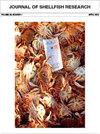甲壳类雌性性激素(CFSH)转录和蛋白谱及其在蓝蟹发育前期蜕皮周期中逐渐发育成体特异性的作用
IF 1
4区 农林科学
Q3 FISHERIES
引用次数: 1
摘要
甲壳类动物雌性性激素(CFSH)在雌性蓝蟹(Callinectes sapidus)发育成虫特有的雌性特征,特别是雌性蓝蟹(Callinectes sapidus)的交配和亲代照顾系统中起着关键作用。因此,本研究的目的是确定CFSH是否与雌性sapidus在其生命周期中特异性表型的发展之间存在关系,以及CFSH的持续存在是否需要在青春期前蜕皮周期中发展成虫特异性特征。首先,从螃蟹3-4期到青春期前,雌性的CasCFSH转录本稳步增加,但在螃蟹15-16期有所下降。青春期前的雌性具有最高的CasCFSH转录本,比成人高5.6倍。青春期前的CFSH蛋白水平最高,但与成年人相似。第一和可见的次要雌性特征包括一对性腺孔或三角形腹部和四对多足类,分别出现在螃蟹阶段的~ 3(甲壳宽度,CW, 5-7毫米)- 5 (CW, 8-10毫米)。在整个青春期前蜕皮周期中逐渐形成的成虫特有的雌性形态特征,只有在青春期末期蜕皮之后才表现出来。通过将CasCFSH- dsrna注射到特定蜕皮阶段的青春期前雌性中,CasCFSH敲低研究提供了进一步的证据:在青春期前蜕皮周期中,CasCFSH的持续存在是逐渐形成成年特异性形态特征所必需的。总的来说,腹部大小是在蜕皮期确定的。然后,腹部形状、性腺孔、胸骨结节、精囊、卵状刚毛和毛在蜕皮间或蜕皮前期形成。最后,毛羽毛在蜕皮间或蜕皮早期和蜕皮后期发育。本文章由计算机程序翻译,如有差异,请以英文原文为准。
Crustacean Female Sex Hormone (CFSH) Transcript and Protein Profiles and Its Functions in Gradually Developing Adult-Specific-Features during the Prepuberty Molt Cycle of the Blue Crab, Callinectes sapidus
ABSTRACT Crustacean female sex hormone (CFSH) plays a pivotal role in developing adult-specific female characteristics, specifically the mating and parental care system of the female blue crab, Callinectes sapidus, manifested after the puberty-terminal molt. Therefore, this study aimed to determine if there is a relationship between CFSH and the development of phenotypes specific to the female C. sapidus during its life cycle and if the continued presence of CFSH is required for developing adult-specific features during the prepuberty molt cycle. First, CasCFSH transcripts in females steadily increase, starting from crab stages 3-4 to prepuberty, except for a decrease at crab stages 15-16. The prepuberty females have the highest CasCFSH transcripts, with ∼5.6-fold higher than adults. CFSH protein levels at prepuberty are the highest but similar to adults. The first and visible secondary female characteristics include a pair of gonopores or a triangular abdomen and four pairs of pleopods seen as early as crab stages at ∼3 (carapace width, CW, 5-7 mm) - 5 (CW 8-10 mm), respectively. The adult-specific female morphological features that are developed gradually throughout the prepuberty molt cycle are manifested only after the puberty-terminal molt. A CasCFSH knockdown study by injecting CasCFSH-dsRNA into prepuberty females at specific molt stages provides further evidence: the continued presence of CasCFSH is required for gradually developing adult-specific morphological features during the prepuberty molt cycle. Overall, the abdomen size is first determined at the intermolt stage. Then, the abdominal shape, gonopores, sternal tubercles, spermathecae, and ovigerous setae and hairs are formed at the intermolt and early premolt stages. Finally, the plumose hairs are developed during intermolt, early, and late premolt stages.
求助全文
通过发布文献求助,成功后即可免费获取论文全文。
去求助
来源期刊

Journal of Shellfish Research
生物-海洋与淡水生物学
CiteScore
2.30
自引率
0.00%
发文量
40
审稿时长
6 months
期刊介绍:
Original articles dealing with all aspects of shellfish research will be considered for publication. Manuscripts will be judged by the editors or other competent reviewers, or both, on the basis of originality, content, merit, clarity of presentation, and interpretations.
 求助内容:
求助内容: 应助结果提醒方式:
应助结果提醒方式:


